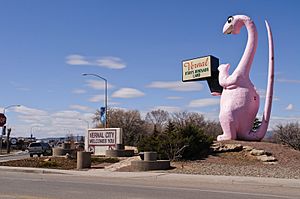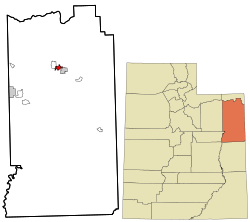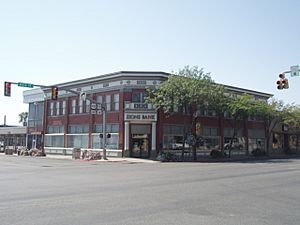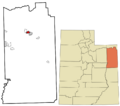Vernal, Utah facts for kids
Quick facts for kids
Vernal, Utah
|
|
|---|---|

East entrance of Vernal (2012)
|
|

Location within Uintah County and Utah
|
|
| Country | United States |
| State | Utah |
| County | Uintah |
| Settled | 1876 |
| Named for | Vernal |
| Area | |
| • Total | 4.62 sq mi (11.97 km2) |
| • Land | 4.62 sq mi (11.97 km2) |
| • Water | 0.00 sq mi (0.00 km2) |
| Elevation | 5,358 ft (1,633 m) |
| Population
(2020)
|
|
| • Total | 10,079 |
| • Estimate
(2022)
|
10,432 |
| • Density | 2,180.7/sq mi (871.95/km2) |
| Time zone | UTC−7 (Mountain (MST)) |
| • Summer (DST) | UTC−6 (MDT) |
| ZIP codes |
84078-84079
|
| Area code(s) | 435 |
| FIPS code | 49-80090 |
| GNIS feature ID | 2412149 |
| Website | vernalcity.org |
Vernal is a city in northeastern Utah, in the United States. It's the biggest city and the main town in Uintah County. Vernal is about 175 miles (282 km) east of Salt Lake City. It is also about 20 miles (32 km) west of the Colorado border.
In 2020, about 10,079 people lived in Vernal. By 2022, this number grew to about 10,432 people. Vernal is home to the Vernal Utah Temple of The Church of Jesus Christ of Latter-day Saints. It also has a campus of Utah State University. The city is a great starting point for visiting places like Dinosaur National Monument, Flaming Gorge, and the Uinta Mountain Range.
Contents
History of Vernal
Vernal was settled differently from most towns in Utah. It was not founded by Mormons moving west. In 1861, a group sent by Brigham Young explored the Uintah Basin. They reported that the area was only good for hunting and for Native American tribes.
That same year, President Abraham Lincoln made the area the Uintah Indian Reservation. Captain Pardon Dodds was put in charge. Around 1868, Dodds built the first cabin there for a white person. Later, more settlers arrived and built cabins near Ashley Creek. In 1879, many people almost died during a very cold winter.
Geography of Vernal
Vernal is located in the Uintah Basin. To the north are the Uinta Mountains. These mountains are special because they run east to west, unlike most mountains that run north to south. The Tavaputs Plateau is to the south, and Blue Mountain is to the east. Vernal itself is in Ashley Valley.
The valley is named after William H. Ashley. He was an early fur trader who came to the area in 1825. He traveled down the Green River in a boat made of animal hides.
Vernal is on the northern edge of the Colorado Plateau. It is south of the Flaming Gorge National Recreation Area. This area is on the border between Utah and Wyoming. The city is in a high desert part of the Colorado Plateau.
The city covers about 4.6 square miles (11.9 square kilometers) of land. There is no water area within the city limits.
Climate in Vernal
Vernal has a cold semi-arid climate. This means it is dry with low humidity. The average temperature each year is about 46.9°F (8.3°C). The average high temperature is 59.8°F (15.4°C), and the average low is 34.0°F (1.1°C).
| Climate data for Vernal, Utah, 1991–2020 normals, extremes 1894–present | |||||||||||||
|---|---|---|---|---|---|---|---|---|---|---|---|---|---|
| Month | Jan | Feb | Mar | Apr | May | Jun | Jul | Aug | Sep | Oct | Nov | Dec | Year |
| Record high °F (°C) | 57 (14) |
64 (18) |
79 (26) |
91 (33) |
101 (38) |
106 (41) |
104 (40) |
102 (39) |
97 (36) |
89 (32) |
72 (22) |
65 (18) |
106 (41) |
| Mean maximum °F (°C) | 42.8 (6.0) |
51.5 (10.8) |
67.5 (19.7) |
77.0 (25.0) |
84.6 (29.2) |
93.6 (34.2) |
96.5 (35.8) |
94.3 (34.6) |
88.9 (31.6) |
76.6 (24.8) |
60.1 (15.6) |
45.7 (7.6) |
97.3 (36.3) |
| Mean daily maximum °F (°C) | 29.2 (−1.6) |
37.1 (2.8) |
51.1 (10.6) |
59.9 (15.5) |
70.2 (21.2) |
81.4 (27.4) |
88.7 (31.5) |
86.0 (30.0) |
76.3 (24.6) |
61.2 (16.2) |
45.7 (7.6) |
31.3 (−0.4) |
59.8 (15.4) |
| Daily mean °F (°C) | 19.6 (−6.9) |
26.8 (−2.9) |
38.8 (3.8) |
46.7 (8.2) |
56.4 (13.6) |
66.0 (18.9) |
72.7 (22.6) |
70.5 (21.4) |
61.2 (16.2) |
48.0 (8.9) |
34.6 (1.4) |
22.0 (−5.6) |
46.9 (8.3) |
| Mean daily minimum °F (°C) | 10.0 (−12.2) |
16.5 (−8.6) |
26.5 (−3.1) |
33.5 (0.8) |
42.6 (5.9) |
50.5 (10.3) |
56.7 (13.7) |
55.1 (12.8) |
46.1 (7.8) |
34.8 (1.6) |
23.5 (−4.7) |
12.7 (−10.7) |
34.0 (1.1) |
| Mean minimum °F (°C) | −4.7 (−20.4) |
0.7 (−17.4) |
13.6 (−10.2) |
20.2 (−6.6) |
29.6 (−1.3) |
37.0 (2.8) |
47.4 (8.6) |
45.3 (7.4) |
33.4 (0.8) |
20.5 (−6.4) |
8.8 (−12.9) |
−2.3 (−19.1) |
−7.8 (−22.1) |
| Record low °F (°C) | −38 (−39) |
−38 (−39) |
−18 (−28) |
0 (−18) |
12 (−11) |
24 (−4) |
25 (−4) |
32 (0) |
19 (−7) |
2 (−17) |
−13 (−25) |
−32 (−36) |
−38 (−39) |
| Average precipitation inches (mm) | 0.62 (16) |
0.56 (14) |
0.68 (17) |
0.75 (19) |
1.04 (26) |
0.59 (15) |
0.54 (14) |
0.81 (21) |
1.22 (31) |
1.15 (29) |
0.51 (13) |
0.61 (15) |
9.08 (230) |
| Average snowfall inches (cm) | 5.8 (15) |
3.9 (9.9) |
1.6 (4.1) |
0.6 (1.5) |
0.0 (0.0) |
0.0 (0.0) |
0.0 (0.0) |
0.0 (0.0) |
0.0 (0.0) |
0.5 (1.3) |
1.6 (4.1) |
6.4 (16) |
20.4 (51.9) |
| Average precipitation days (≥ 0.01 in) | 5.3 | 5.3 | 4.6 | 5.6 | 7.0 | 4.2 | 4.2 | 5.2 | 5.8 | 5.4 | 4.3 | 5.0 | 61.9 |
| Average snowy days (≥ 0.1 in) | 3.9 | 3.5 | 1.3 | 0.4 | 0.1 | 0.0 | 0.0 | 0.0 | 0.0 | 0.4 | 1.2 | 3.7 | 14.5 |
| Source 1: NOAA | |||||||||||||
| Source 2: National Weather Service | |||||||||||||
People of Vernal
| Historical population | |||
|---|---|---|---|
| Census | Pop. | %± | |
| 1880 | 799 | — | |
| 1890 | 1,305 | 63.3% | |
| 1900 | 664 | −49.1% | |
| 1910 | 836 | 25.9% | |
| 1920 | 1,309 | 56.6% | |
| 1930 | 1,744 | 33.2% | |
| 1940 | 2,119 | 21.5% | |
| 1950 | 2,845 | 34.3% | |
| 1960 | 3,655 | 28.5% | |
| 1970 | 3,908 | 6.9% | |
| 1980 | 6,600 | 68.9% | |
| 1990 | 6,644 | 0.7% | |
| 2000 | 7,714 | 16.1% | |
| 2010 | 9,089 | 17.8% | |
| 2020 | 10,076 | 10.9% | |
| U.S. Decennial Census | |||
In 2020, Vernal had 10,076 people living there. There were 3,217 households, which are groups of people living together. About 2,095 of these were families. The city had about 2,180 people per square mile.
Most people in Vernal were White (83.17%). Other groups included Native American (3.68%) and Hispanic or Latino (8.62%).
About 37.79% of households had children under 18. Most households (57.8%) were married couples. The average household had about 3 people. The average family had almost 4 people.
The average age of people in Vernal was 30.5 years. About 30.7% of the population was under 18. About 8.54% were 65 or older.
The average income for a household in the city was $50,692. For families, it was $34,453. About 19.0% of all people and 14.7% of families lived below the poverty line.
Vernal's Economy
Vernal's economy mainly relies on getting natural resources from the earth. These include petroleum (oil), natural gas, phosphate, and uintaite, also known as gilsonite. Because of these resources, companies like Halliburton and Schlumberger have offices in Vernal.
Tourism is also important to Vernal's economy. The city has a history tied to the Old West. It is also a major place to find ancient dinosaur fossils. Vernal and the areas around it are popular for outdoor enthusiasts. People enjoy fishing, fly fishing, hunting, and other outdoor activities there.
Education in Vernal
Vernal has several public schools. These include Ashley Valley Education Center, Uintah High School, Uintah Middle School, and Vernal Middle School. There are also elementary schools like Ashley Elementary and Discovery Elementary.
For higher education, Vernal has branches of Utah State University and Uintah Basin Technical College. In 2015, a new K-12 charter school called Terra Academy opened. Private schools include White House Academy and Uintah Basin Christian Academy.
In 2007, the Uintah School District built new buildings for two elementary schools, Maeser and Naples Elementary. This helped with more students and replaced older buildings. Other schools in the area are Davis Elementary, Lapoint Elementary, and Eagle View Elementary (for pre-kindergarten through 8th grade). The National Outdoor Leadership School (NOLS) also has a Rocky Mountain River Base here.
Transportation in Vernal
Highways for Travel
Vernal is located on two important federal highways. U.S. Route 40 runs east and west. U.S. Route 191 runs north and south. When you head west from the city, these two highways share the same road.
Vernal Regional Airport
The city has the Vernal Regional Airport. You can fly directly from Vernal to Phoenix (PHX). These flights are operated by Contour Airlines using jet aircraft. The flights are supported by a program called Essential Air Service (EAS). There are also twice-weekly flights to Salt Lake City with Redtail Air.
Public Transportation Options
Vernal is served by two routes from the Basin Transit Association. One route goes from Vernal to Roosevelt, where you can connect to another route to Duchesne. The other is a local route that goes around Vernal. There is also a Salt Lake Express bus route that connects Vernal to Salt Lake City.
Fun Things to Do in Vernal
Special Events to Enjoy
- Dinosaur Roundup Rodeo: This is a yearly rodeo event held in Vernal in early July. It has been happening since the 1930s. It's known as one of the best outdoor rodeos and attracts many competitors.
- Dinah "Soar" Days & Hot Air Balloon Festival: This festival features a multi-day hot air balloon event. There are also many other community activities, often with a hot air balloon theme.
- The John Wesley Powell River Festival: This festival celebrates the history of exploration in the region. It includes live music, food trucks, and activities focused on local history.
- Games, Anime, and More (G.A.M.) Convention: This is a fan convention held twice a year, in March and August. It includes video games, card games, cartoons, costumes, tournaments, and tabletop gaming. It was the first convention of its kind in Vernal.
- Uintah County Fair: This fair happens every year from Thursday to Saturday during the second week of June.
Places to See
- Lookout Point: This spot is on the western edge of the city. It offers a great view overlooking Ashley Valley, where Vernal is located.
Famous Buildings in Vernal
- The Bank of Vernal Building: This building is also called the 'Parcel Post' Bank. It is a historical building in Uintah County. It got its nickname because it was built in 1916–1917 by William H. Coltharp. He used the mail service to ship about 80,000 bricks from Salt Lake City to Vernal. The bricks weighed 50 pounds (22.6 kg) each. The trip was over 420 miles (675.9 km) long! After this, the U.S. Post Office quickly changed its rules. They set a limit of 200 pounds (90.7 kg) per day for each sender. The Postmaster General said that buildings should not be shipped through the mail. Today, the building is a branch of Zions Bank.
- The Quarry Visitor Center: This building is located in Dinosaur National Monument. It is another important building near Vernal.
- The Vernal Utah Temple: This is a small LDS temple. It was built inside the old Vernal Tabernacle. People worked to save the old tabernacle when it was planned to be torn down.
Famous People from Vernal
- Ron Abegglen: A former basketball coach for Weber State. He was born and grew up in Vernal.
- Earl W. Bascom: An inventor, rodeo cowboy, artist, and sculptor.
- Texas Rose Bascom (1922-1993): A rodeo performer and Hollywood actor. She is in the National Cowgirl Hall of Fame.
- Clair Burgener: A U.S. Representative from California (1973–1983).
- Lane Frost: A famous rodeo star and world champion bull rider. He went to junior high school in Vernal.
- E. Gordon Gee: An academic who has been president of more universities than any other American.
- Douglas Kent Hall: A writer and photographer who won an Academy Award.
- Dallin H. Oaks: A former president of Brigham Young University and a Utah Supreme Court Justice.
- Dennis Preece: A Hall of Fame wrestling coach at the local high school in Vernal.
- James Woods: A film and television actor who was born in Vernal.
Images for kids
See also
 In Spanish: Vernal para niños
In Spanish: Vernal para niños




